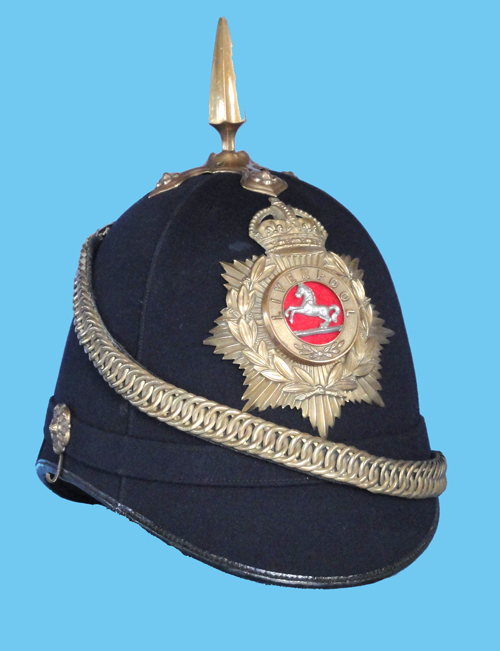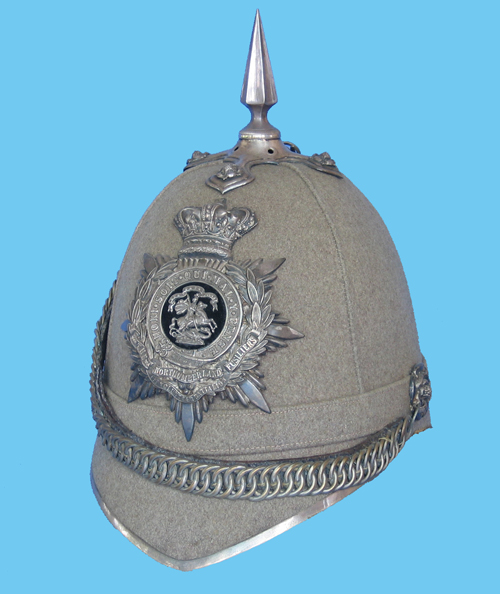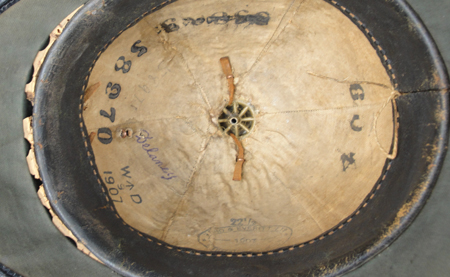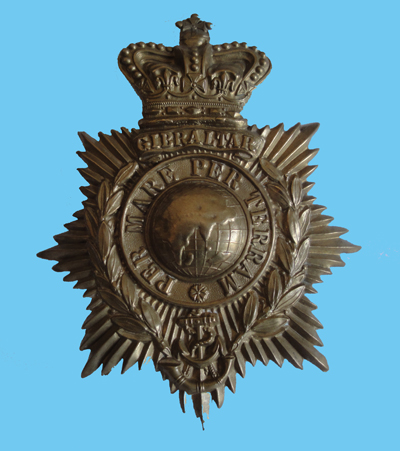
An example of an officer’s version of the Home Service Helmet. This one is provenanced to W. Swan of the Army Ordnance Department. (Author’s collection)
While we focus on sun helmets on this website these are, of course, only one form of headgear among many worn by armies throughout history. The subject of this article is the British Home Service Helmet, which in this writer’s opinion was inspired by the Colonial Pattern sun helmet worn in India from at least as early as the 1850s.
“In 1878, nearly forty years after it was first mooted as an alternative headdress, a helmet was approved for the Infantry. Made of cork and covered with blue cloth (dark green for Light Infantry [and Rifle Regiments]), this helmet had a spike as did the Prussian model, which had inspired its adoption, but its silhouette owed more to the white foreign-service helmet adopted by the British a few years before.” 1 For a discussion on the spike and its origins click here.

An example of the Foreign Service Helmet illustrating the similarity of style with the Home Service Helmet. (Author’s collection)
The Home Service Helmet was authorised for the British Army in General Order 40 of May 1878, although it had been on trial for a few years prior to this date. 2 The take-up of the helmet took some time, as was normal procedure, with old stock and current issues of the previous headgear being worn to the limit of useful wear, which was probably up to 1881. 3
British Army Dress Regulations, for officers only, state that the helmet was to be “Cork, covered with blue cloth in four seams, two on each side; peaks front and back, stiffened and covered with cloth with a seam at each side; the front peak bound with metal 3/16 inch wide, the back peak with patent leather 1/8 inch wide. Above the peaks and going round the helmet a cloth band ¾ inch wide, and stitched top and bottom. Back peak to centre of crown 10 ½ inches; front peak to centre of crown 10 ¼ inches; side to centre of crown 8 inches. Gilt curb chain chin strap, the links 5/8 inch wide and strap lined with black velvet. Gilt rose fastenings at each side; gilt convex bar ¼ inch wide, down the centre of the back, and to the bottom of the back peak. The bar is in one piece, and is fastened to the helmet by means of two studs and a flattened prolongation of the bar under the back peak. At the top of the helmet, a gilt spike mounted on a cross-piece base…”
It must be noted that chin chain widths vary considerably from the official 5/8 inch and many examples are seen of ¾ inch and to a lesser extent 1 inch.

An example of the “ball in leaf cup” top-piece and a volunteer unit’s (silver or white metal furniture) officer’s Home Service Helmet to the Army Service Corps. (Author’s collection)
The spike was replaced by the “ball in leaf cup” device shown above for the Royal Field Artillery, the Royal Garrison Artillery, the Army Service Corps, the Royal Army Medical Corps and the Army Veterinary Corps, although the Royal Artillery wore the spike until 1881.
All metal furniture was of gilt for officers, except Rifle Regiments which used bronze metal. Volunteer battalions used silver or white metal fittings. Grey cloth versions, worn by Volunteer Corps, had white metal/silver or bronze furniture.
Other Ranks (EMs) wore an inferior quality helmet, the officers’ being private purchase items, and differed from the officers’ in several respects; the brim being bound in leather all round, no back strap, the cruciform base being one-piece and often only being attached by two lugs, the helmet plate being of brass rather than gilt and of a different design having that of a common backing with a regimental centre device, the spike being set into the cruciform base rather than sitting “proud” of it, and the chin chain had only leather backing i.e. no velvet.

An example of an OR’s helmet showing the patent leather binding, the spike and cruciform base and standardized helmet plate with regimental centre device. (Author’s collection)
The cruciform base of an officer’s helmet had four rosette screw thread fittings which perforated the helmet shell and were secured by nuts, either plain or with “looped handles.” Other Ranks’ helmets had integrated rosettes with most commonly only two lugs, rather than screw posts, which perforated the shell, and these were normally positioned east/west and secured by cotter/split pins or triangular leather wedges.

The interior of an officer’s helmet showing the securing nuts and the sumptuous leather headband with silk attachment which was almost universal on officers’ versions. (Author’s collection)

The interior of an Other Rank’s helmet showing the two lugs securing the spike base with leather wedges although these seem to be not contemporary with the helmet. (Author’s collection)

The spike and cruciform base of an officer’s helmet. Note that the spike sits on top of the base. The fact that the rosette fixtures were separate entities is clearly visible from the rear one as is the hook used to hold the chin chain when not worn down. (Author’s collection)

An example of an Other Rank’s spike and base illustrating how the spike sat in the base. That the rosettes are integral to the base is also evident. (Author’s collection)
Helmet plates were of three basic designs; an eight pointed star surmounted by a crown, for Rifle Regiments a Maltese Cross surmounted by a crown, and the Royal Coat of Arms. From 1878-1901 the St. Edwards Crown was used and from 1901-1939 the Tudor Crown. These are known as the Queen’s crown and King’s crown respectively. There were exceptions to these designs, for example, the King’s Own Scottish Borderers and the Cameronians (1881-1892).

Variations on the basic design. From left; King’s Royal Rifle Corps, King’s Own Scottish Borderers, Cameronians.
For officers the plate was usually of a three piece construction being; the rayed backing star, the garter and wreath with a “universal” scroll for the regimental name, and a centre device. A two piece construction was also used where the garter and wreath were integral with the centre device.

An example of the design and construction of an officer’s helmet plate of the three pieces type. Note the holes through which the lugs attached to the garter and wreath and the centre device were passed and secured to the backing plate by cotter/split pins.
The arrangement of the holes in the officers’ backing plate varied from the two examples shown above with backing plates having four holes arranged north/south/east/west and some with three holes arranged top left and right and bottom presumably to suit the centre device. The whole helmet plate had three lugs (middle top and left and right bottom) which pierced the cork shell and were normally held in place by triangular wedges of leather.

A superb example of a helmet plate showing the method of attaching the centre device and the three lugs which secure the plate to the helmet. It is interesting to note that the bottom lug, through which the cotter pin passes, secures the regimental scroll which is separate from the garter and wreath. (Photo courtesy of Benny Bough)

An example of an Other Rank’s two piece helmet plate. There were from two to four lugs to the rear of the centre piece corresponding to the holes in the backing plate. When four lugs are present the fourth is in the centre of the device.

The reverse of an Other Rank’s backing plate. This example shows the two lower lugs having been removed. (Author’s collection)

The centre device corresponding to the backing plate above. This example has two lugs. (Author’s collection)
There seems to be considerable latitude used in the fixing of the helmet plate and its centre device. Of the writer’s two Other Rank’s examples the first (above) has the two lugs of the centre device penetrating the helmet shell together with the top lug on the backing plate, all secured with leather wedges.

This Senior NCO’s backing plate has two lugs with an additional three on the centre device, all of which penetrate the helmet shell. (Author’s collection)
The second has all three lugs on the centre device penetrating the shell and two lugs (east/west) on the backing plate also penetrating the shell and all secured by cotter/split pins.

A Grey cloth version of the Home Service Helmet normally associated with Volunteer Battalions but some volunteer units wore the blue cloth version. (Author’s collection)

Another variation to the helmet plate, this helmet being to the Eton Rifle Volunteers. (Author’s collection)
One of the major complaints of the Home Service Helmet 4 was its lack of any real ventilation; that allowed through the top via holes in the spike base proving quite inadequate. Corrugated cork inserts between the headband and the shell were used, usually front and/or back. Examples seen by the writer all date from the early 1900s and are all Other Ranks versions.

Cork ventilation between the headband and the helmet shell. This example has the cork at the front of the helmet. (Author’s collection)
The Home Service Helmet was in use by most Infantry regiments, Royal Field Artillery, Royal Garrison Artillery, Royal Engineers, Army Service Corps, Royal Army Medical Corps, the Army Ordnance Department and other Corps and Departments. It was not worn by Highland regiments, Fusiliers, Rifle regiments who re-adopted the Rifles’ lambskin busby in 1890, the Highland Light Infantry, the Cameronians who re-adopted a shako in 1890, Cavalry and Royal Horse Artillery nor the Foot Guards. It was the full-dress helmet from 1878 to 1914 when full-dress was withdrawn and never re-issued, however it was used for tattoos and is still in use today for some regimental bands.
This style of helmet was worn by various Dominion/Colonial forces in Canada, Australia and New Zealand.
Stuart Bates
1 Barthorp, Michael, British Infantry Uniforms Since 1660, Blandford Press, Dorset, 1982
2 Latham, Robert & Christopher, Home Service Helmet 1878-1914, Star Products, London
3 Op. cit.
4 Headdress Committee Report, HMSO, 1896
5 Wedd, Monty, Australian Military Uniforms 1800-1902,Kangaroo Press, Sydney, 1982






Excellent Article Stuart…very informative.
I am an collector of military and police hats and helmet.I got your book and use it for identification a lot.I have a question.Till what date were boer war shaped pithhelmets
made.If you got another e-mail address i could send you photos .
Axel Greif
Australia
Axel,
I am on holiday in Europe at the moment but it is my belief that the Colonial Pattern helmet was finally replaced by the Wolseley in or around 1910.
Regards.,
Stuart
I have just returned home and waiting for me was a photo of “the King’s Bodyguard of 100 picked men of the Royal Marine Artillery” dated 1914 and they are all wearing the Colonial pattern white helmet.
This would indicate that, at least, for special occasions this style of helmet was used up to WWI.
Stuart
I’ve recently found a “spike/cap device” that looks very similar to some you’ve posted. Would you please email me? Many thanks and a Wonderful article!
TK
Where can i get some books on these helmet information and cost?
Hi Mike,
there is only one book(let) that I know of and it is Home Service Helmet 1878 – 1914 by the Wilkinson-Lathams and distributed by Star Products. You could always buy the Dress Regulations for the Army 1900. This gives the same information as the booklet ( actually vice versa) but is the official specification for Army officers. Both are available – just Google them.
If you have any specific question I would be happy to help.
Regards,
Stuart
Is there any evidence that the helmet had a foul weather cover at all, (for example like the lancers?). I’ve seen no evidence for this but would have thought it wouldn’t survive poor weather for too long without some protection.
Hi Rob,
interesting question but not one that I can give a definitive answer on. I have never seen nor read of any cover. Certainly not mentioned in the relevant The Dress Regulations for the Army.
Cork contains a substance Suberin which is highly impermeable to water. Worthy of note is that cork was used, and still is, as stoppers for say wine bottles.
Stuart
I have been learning to restore damaged 1878 style helmets after collecting some that had been crushed or smashed at the top, but l wanted to know if anyone knows where l could get replacement skins for them as sewing your own is near impossible to get the fitting totally Correct.
I want to restore as keeping the history of our past alive in so very important.
Search the net for information. I searched for “applying a cloth cover to a helmet.”
Hi Jon,
you have set yourself quite a task. You could seek out those who manufacturer replicas in the UK.
I have no real idea as to how it was done but I think that the cover being made and the shell plastered with shellac or some such the cover was steamed and stretched over the shell to shrink as it dried.
The is a book http://www.gutenberg.org/ebooks/47090 which may be of help.
Stuart
Thank you all for the help. I found the book very helpful. I have found that most companies are unhelpful to a level of being very rude if you ask them questions and CW Headwear were the worst.